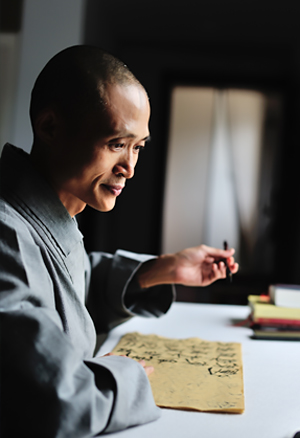FEATURES|VEHICLES|Mahayana
Convergence and Harmony: On the Schools of Chinese Buddhism
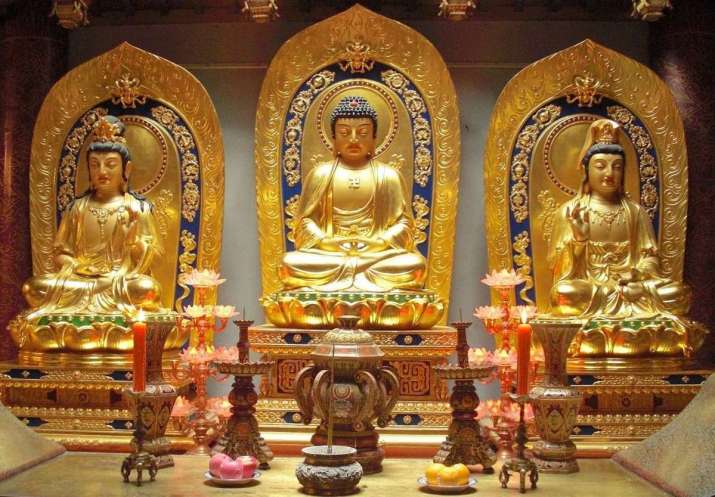 Amitabha Buddha with his bodhisattva attendants Avalokitesvara and Mahasthamaprapta in Hangzhou, Zhejiang Province. From wikipedia.org
Amitabha Buddha with his bodhisattva attendants Avalokitesvara and Mahasthamaprapta in Hangzhou, Zhejiang Province. From wikipedia.orgI. The establishment of the schools
When people talk, act, or write, they follow specific motifs. As the Chinese saying has it, “Despite all changes, the core theme stays the same.” Buddhist practice must all the more be guided by particular lines of Dharma teaching or a school of thought. A school offers a central system that supports adherents and allows them to practice effectively, without losing their way.
Buddhism was introduced to China from India through the translation of scriptures. On most occasions, translation centers concurrently served as teaching venues. Whenever a sutra was translated, its Chinese version would immediately be expounded, studied, and circulated. Things were simple in those times and the need for Dharma schools was not yet an issue. As translations accumulated, however, the situation became increasingly complex.
First, Buddhist scriptures contained numerous Dharma paths—some 84,000, as it is said. The vast number of texts meant it was impossible for ordinary people to learn them all. How should a practitioner choose? Second, there are substantial differences between the Dharma paths. How can they be classified coherently? Third, teachers of the Dharma instruct differently. For a given sutra, interpretations may vary and even contradict one another. Which explication should a learner rely on?
Faced with this dilemma, practitioners inevitably ask themselves, “Which method should I choose—and why? How do I practice? And how should I regard the other Dharma paths?”
At first those questions were personal and somewhat random. But as they became widespread and consensual, there arose in Buddhist circles a movement to establish schools of thought and practice. A few centuries of effort led in the Sui-Tang period (the Sui and early Tang dynasties) to the formation of eight Mahayana schools in China. These schools provided the eight theoretic systems to guide their practices.
The Buddhist schools were China-specific. Formed after the Buddha’s teachings entered the country, they showcased the fundamental characteristics of Chinese Buddhism. In the context of the schools’ creation, people invariably focused on the founding patriarchs’ roles and contributions. This is understandable, but in reality it was not a mission that a few patriarchs could accomplish over their short lifetimes. The process consolidated the achievements explored, pursued, and participated in by Buddhist practitioners over the six or seven centuries after Buddhism entered China until the Sui-Tang era. The founding masters, in their wisdom, merely applied the finishing touches to this ongoing, extensive mass effort.
With such a deep-rooted popular foundation, the creation of schools symbolized the flourishing and entrenchment of Buddhism in China. Thenceforth they would have a lasting and profound influence, even as they strode onto the international stage.
The founding of the schools was a milestone not only in the history of Buddhism in China, but in the world. It was an inevitable and irreversible process. It met the actual requirements of Buddhist practice, and was an inescapable result of the need to select, cultivate, and propagate specific Dharma paths. Yet some people today are unfamiliar with the context. They allege that the various doctrines are complicated and the creation of schools unnecessary. Lacking vision and knowledge, they even denigrate the founding of schools as sectarianism. Practicing without following a school, or without an awareness of the need to follow a school, is like sailing on the ocean and discarding the compass, or traveling in the dark while failing to recognize the Big Dipper. Such an indiscriminate approach was given the fine-sounding name of “simultaneous practice and propagation of multiple approaches” or “perfect interpenetration without obstruction.” In fact, it undermined the foundations of Buddhism and was a sign of decline.
II. The evolution of the schools
After the schools were established, their norms were adopted as benchmarks for their respective activities relating to propagation and practice. The Yogacara, Sanlun (“Three Treatises” or Madhyamaka) and Esoteric schools did not last long and were suspended. The Vinaya (Precepts) school was later replaced by the “pure regulations.” Of the eight major schools, four enjoyed relatively enduring popularity and influence: the Tiantai, Huayan, Ch’an, and Pure Land. The first two, due to the abundance and rigor of their theories, were called “scripture-based schools” (Ch: jiaoxia). Ch’an described its own lineage as “transmission without sutras” (Ch: zongmen).
In the lengthy course of their propagation, the schools’ doctrines inevitably interacted with and influenced one another, as did the respective methods of practice. Even so, each school managed essentially to preserve its own features. The reason: before the doctrines of a school could penetrate the thought system of another school, they had to undergo interpretation by the latter, which basically “localized” them. It is therefore evident that the various traditions’ theories were sufficiently sophisticated and mature to enable each school to be accommodating toward others. At the same time, they provided the school in question with a self-protective function, akin to a firewall. That enabled it to absorb useful ideas from the doctrines of others to serve its own interests.
The Pure Land school was an exception. On the one hand, all other schools converged with it, making Pure Land increasingly influential. On the other, the school lost its original founding philosophy and became unable to withstand absorption and transformation by other traditions. As a result, while it turned into a “shared sect,” it also became a “dependent” one—the largest school with the least school-specific attributes.
The convergence of other paths with Pure Land was the result of changes over time. As their declining aptitudes made people increasingly unsuited to practice the self-power paths, they converted to the Amitabha-recitation of Pure Land and sought rebirth in the Land of Bliss. Ordinary folk lacked the mental strength and intelligence to study and grasp the doctrines of the Tiantai and Huayan schools, let alone practice “Threefold Contemplation in One Mind” according to the former’s principle of “Three Thousand Realms in a Single Thought,” or to cultivate “Perfect Interpenetration of the Dharma Realm” in line with the latter’s “Ten Kinds of Non-obstruction.” The Ch’an school was even more profound and difficult. Suitable only for practitioners of superior capabilities, it left the less accomplished at a complete loss.
Hence, shortly after or even upon the founding of the other schools, their monastic leaders started either to compose commentaries on the Pure Land tradition or to practice it concurrently with their own schools’ cultivation. For example, renowned Tiantai patriarch Master Zhiyi wrote commentaries on the Pure Land and, at the point of death, was accompanied by auspicious signs heralding rebirth in the Land of Bliss. Thenceforth, all Tiantai practitioners simultaneously practiced Pure Land. Thus the saying, “Tiantai and Pure Land are one indivisible family.”
In other schools such as Huayan, Ch’an, and Vinaya, countless eminent monks who practiced personally and enjoined others to do likewise, also aspired to rebirth in the Land of Bliss. That contributed to the trend of convergence with Pure Land. By the Ming and Qing dynasties, the Pure Land school already took under its wing the other traditions. The recitation, “Namo Amitabha Buddha,” came to represent all of Buddhism. In modern times, more than 90 per cent of Chinese Buddhists practice the Pure Land path.
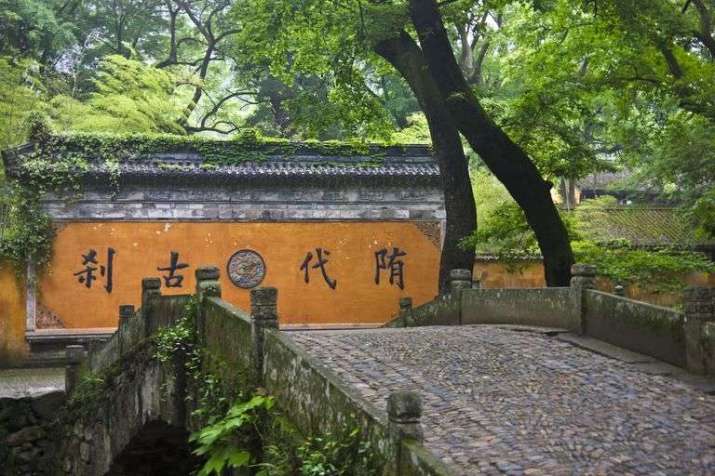 Screen wall at the entrance to Guoqing Temple, Tiantai Mountain in Zhejiang Province. Tiantai Buddhism was first established at Guoqing. From thoughtco.com
Screen wall at the entrance to Guoqing Temple, Tiantai Mountain in Zhejiang Province. Tiantai Buddhism was first established at Guoqing. From thoughtco.comBut the “Pure Land school” formed as a result of the convergence saw a great dilution of the characteristics that distinguished it when Master Shandao established the lineage. Its theoretical structure and forms of practice adhered to the norms of the schools of the Sacred Path (non-Pure Land schools). Such compliance obscured the school’s own fundamental features—“recitation of Amitabha’s name, relying on his Fundamental Vow (the 18th)” and “rebirth of ordinary beings in the Pure Land’s Realm of Rewards.”
That’s because in the late Tang–early Song period, the core texts on which the Pure Land school was founded became lost in China. They included Master Shandao’s Commentary on the Contemplation Sutra, Master Daochuo’s Collection on the Land of Peace and Joy and Master Tanluan’s Commentary on the Treatise on Rebirth in the Pure Land. The absence of these works meant that later generations of practitioners lacked benchmarks for reference. In order to practice and propagate Pure Land, they were obliged to rely, if only expediently, on the other schools.
In the late Qing–early Republican era, Householder Yang Renshan shipped back from Japan the Commentary on the Contemplation Sutra and the Commentary on the Treatise on Rebirth in the Pure Land. Only then did a clear and complete theoretical framework for the Pure Land school begin to emerge, underpinning practice methods.
Thanks to today’s convenient transportation and advanced information technology, besides traditional Chinese Buddhism, we have easy access to other paths, such as Theravada and Vajrayana Buddhism. In addition, “humanistic Buddhism” has become a new trend. Tibetan Buddhism stresses the purity of lineages, so its sectarian characteristics are still distinct. This is a precious feature. However, modern people are restless and facile. They have little patience for meticulous, complex teachings, habituated as they are to “fast-food” culture. If someone casually designates a sutra or advocates a particular Dharma path, he can quickly attract a large following. People no longer know what a “school” means, and have little interest in finding out. Of course, a serious seeker or practitioner would never be so rashly indiscriminate. Given the earlier “convergence,” the Pure Land school must revert to what it originally was, and resume its independent and integral status. Only then will Buddhism be able to stand straight again after a long period of decline. For contemporary Buddhists, it is also the task of the times.
III. The definition of “school”
In his Essays on the Forest of Meanings in the Mahayana Dharma Garden, Master Kuiji (Master Xuanzang’s disciple) of the Yogacara school explains that the term “school” carries the meanings of supreme, sublime, and dominant. “Supreme” means superior, pre-eminent. “Sublime” signifies revered and admired, and “dominant” evokes an overall command. Extended meanings of “school” include “esteem exclusively,” “have dominion over,” “uniquely,” and “most extraordinary.”
A school can only exist by incorporating supreme, sublime, and dominant elements from the 84,000 Dharma paths. Otherwise, there is no school. Accordingly, we can give “school” a simple definition: a doctrinal system that takes as supreme only one of the Dharma paths expounded by the Buddha, and applies it to govern all the others.
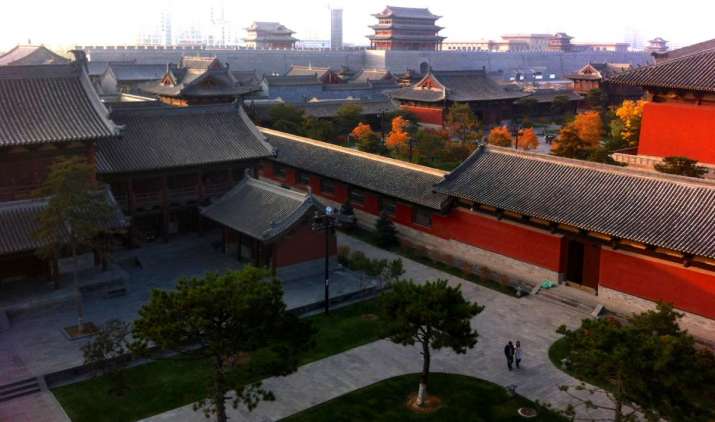 Huayan Monastery, Datong in Shanxi Province. From pinterest.com
Huayan Monastery, Datong in Shanxi Province. From pinterest.comIV. The features of a school
This definition tells us that a school has the following features: exclusiveness, pre-eminence, and systematic structure.
1. Exclusiveness
A school solely and exclusively honors a Dharma path. No other path can co-exist with it on a parallel and equal basis. Two kings cannot rule the same kingdom. Within a school, it is impossible to have two equal, parallel traditions. The Ch’an school, for instance, stresses the principle of “pointing directly to the mind and achieving Buddhahood by perceiving one’s own nature.” The Pure Land tradition exclusively advocates the recitation of Amitabha Buddha’s name. Such exclusiveness is necessary to found schools. In its absence, no school can come into existence.
These were not arbitrary requirements imposed by patriarchs while creating their schools. Rather, the pertinent principles already existed in the Buddhist sutras, and were adopted as the basis for the founding of schools. For example, the Lotus Sutra says: “There is only the law of the One Vehicle, not two and not three.” That was the premise on which the Tiantai school was established. The Infinite Life Sutra acclaims Amitabha Buddha, noting that as Bhikku Dharmakara, he had “made vows unrivaled in all the worlds.” The scripture also says, “No other Buddha’s light can match” Amitabha’s, and that Amitabha Buddha is “the king of all Buddhas, and supreme among all sources of light.” The Pure Land school was founded accordingly.
2. Pre-eminence
A school applies its exclusively esteemed Dharma path to dominate and incorporate all other traditions. That is so the entire Dharma can be taken into account and reconciled with the founding of that particular school. If the school’s Dharma path failed to prevail over all others, its pre-eminent status would not be assured.
For example, compared with the Mahayana (Greater Vehicle), the Lesser Vehicle is unable to evoke exclusive esteem because it manifests a relatively limited capacity of mind and its attainments are finite. How can it dominate or incorporate the Mahayana paths? But the latter may do so with the former.
The Mahayana comprises different traditions. They include gradual and sudden paths, expedient and ultimate lineages, and partial and complete teachings. It is always the sudden, ultimate and complete heritages that encompass the gradual, expedient and partial ones.
3. Systematic Structure
Pre-eminence must be supported by an architecture wherein all Dharma paths are properly positioned according to their outward aspects, status, value and function, thereby forming an integral and rigorous system.
Such a system ensures the overall dominance of the school’s own Dharma path, even as it maintains the integrity of all the Buddha’s teachings and positions the various traditions appropriately. This way, the school can absorb useful teachings from other paths and formulate a set of independent principles to guide its adherents in their study and practices. Without the system, there would merely be fragments, full of loopholes. Forming a school would be impossible, let alone directing the practice of followers.
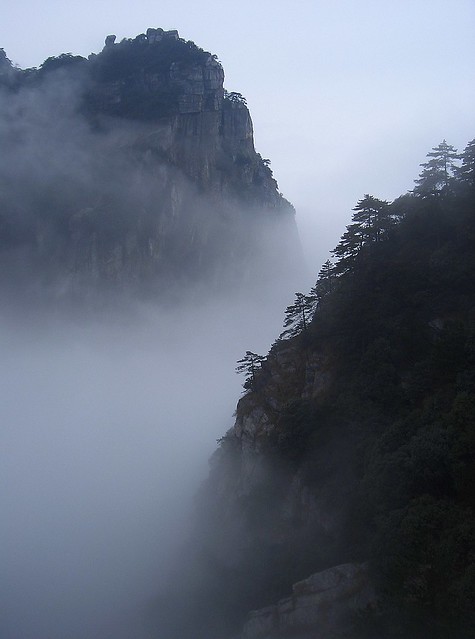
Fog curls around the peaks of Mount Lu (Lushan) in Jiangxi Province, where
the Chinese Pure Land tradition was founded. From wikipedia.org
V. A school in a mature and complete sense
A school is formed after a gradual process of development and maturation. The initial motivation was the need of individual practitioners, which later became an imperative to guide the practice of much larger groups. Efforts began with the study of one or several scriptures, then extended to the analysis, appraisal, and classification of the Buddha’s entire teaching. A mature and complete Dharma school must be characterized by exclusiveness, pre-eminence, and a systematic structure. Without these features, formation of a school would be premature.
The founding patriarchs obtained exceptional inspiration from their own study and practice of the Dharma. Out of compassion for other beings, they wanted to propagate their chosen paths, so they set out to create the schools. They didn’t do so to glorify themselves or pursue sectarian independence. Unlike the Buddha himself—the only one capable of delivering beings of all aptitudes and teaching all Dharma paths—Buddhist masters must, when propagating the Dharma, rely on their own schools’ methods to influence and transform those with karmic affinities.
The schools were founded to propagate the Dharma, and propagation must follow the schools’ systems of thought. The “exclusiveness” was necessary for a school to highlight its own Dharma teaching. Its “pre-eminence” guaranteed that the school incorporated all other doctrines. And the “systematic structure” maintained an orderly relationship between itself and other schools. Once established, the system did not allow disruption. It would reject alien factors, the same way living organisms might. Once in place, the system must maintain stability. If it were disrupted and fell apart, its “exclusiveness” would vanish and its propagation efforts would fail.
A living entity only accepts what is compatible with its bodily systems and rejects other elements. For example, in bone-setting or fracture plating, the body will reject non-homogeneous implants. A mature, complete school is like a living organism. It has a life and energy flow of its own, and hence a rejection function. Otherwise, the school would not be able to provide proactive guidance to its adherents in their practice. It would be as good as dead.
As to the “rejection,” it was subject to the premise that a system had been created to accommodate the Buddhist teachings in their entirety. The sole purpose of rejection was to preserve the purity of the school-specific doctrines. Therefore such rejection would not affect the whole of Buddhism.
The establishment of schools in Chinese Buddhism offered twin benefits: on the one hand, each school effectively accentuated its own Dharma path; on the other, it embraced all other approaches. Such attributes allowed people to more easily choose practice methods with which they had karmic affinity, so that Dharma teaching expanded in an orderly manner. The founding of schools was a great breakthrough by the Chinese patriarchs, a tribute to their wisdom.
By stressing its own doctrines, a school was able to enhance the confidence of karmically compatible followers. And because it incorporated all other approaches, it allowed other schools to interact and evolve. Thus the eight major schools did not constrain one another. On the contrary, they cooperated even as they moved separately towards a common goal—the well-organized propagation of the entire Dharma.
The history of Chinese Buddhism shows that from the formation of the schools through their development and evolution, they have coexisted harmoniously and flourished together. They remained free of sectarian rift, let alone sanguinary conflict. This amply underscores the truth of sunyata (Skt. emptiness) and the spirit of compassion taught by the Buddha. It also reflects the benevolence and wisdom achieved by the patriarchs, in their efforts to benefit themselves as well as others.
English translation by Foqing, edited by Jingtu.
Buddhistdoor Global Special Project

